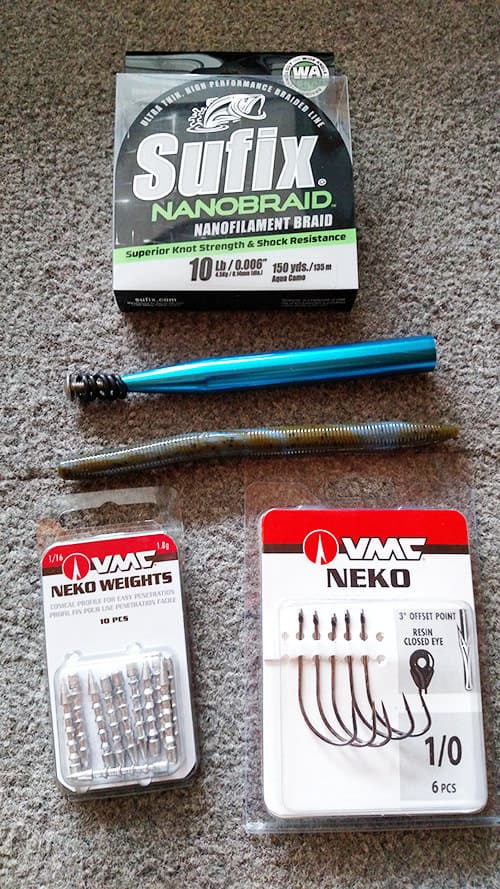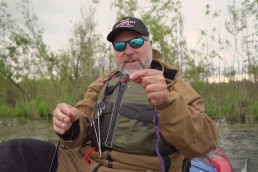Spinning Gear for Bass is Better than Ever
SHARE THIS POST
I have fished for both largemouths and smallmouths on spinning gear more over the last 10 years than in my entire lifetime. Innovations in not only rods and reels, but hooks, lures and line have added to the benefits and power of spinning gear.
My rule of thumb for freshwater fishing is, when it comes to choosing between baitcasting and spinning gear is based on line size. Any line with 10-pound-test and less is fished on spinning gear; any line with 12-pound-test and over is fished on baitcasting gear. Yes, there are exceptions, but that rule is easily applied to lure weights and rod actions when I base it off of line size. I choose spinning gear when I need to use smaller and/or natural-colored lures in clearer water. With that being said, herer are a few items including techniques that involve spinning gear.

Wacky worm
When I first read and saw this technique years ago, my intial reaction was without question, it was the most stupid-looking thing I ever saw—seeing a worm hooked through the middle as it wiggled ever so slightly toward the bottom looked idiotic. That is, until I made about three casts and a bass inhaled it. I have caught more bass on a wacky worm than any other soft plastic creation, and I fish a lot of them. I rig a wacky differently than most and have showed this through video episodes and seminars to thousands of people, and still it’s the most effective way for me to catch bass. I use a “wacky tool” to insert the worm into, slide the rubber O-ring over the tube and on the worm halfway between the thick and tappered end. Then I insert a 1/0 octapus-style hook under the O-ring. When a bass strikes, I simply pull back and the VMC octopus hook, which has a 3-degree turnout, rotates into the jaw of the bass. The highly-effective, smaller hooks make skipping the worm under docks and working around brush much easier.
Neko rig
The Neko rig, I would say, is a combination of the wacky rig and shaky head technique. It’s the same worm you would use for wacky worming, as well as a 7-inch straight-tailed worm. Rapala has designed weights and hooks specifically for this technique: The nail weight is inserted into the head of the worm (or thickest end). Then you can either hook the worm (1/3 of the worm), or as with the wacky worm, use the O-ring and insert the hook upside down with the point of the hook facing the bottom. As the lure is cast out and sinks to the bottom, a tight line causes the worm to stand up. Shaking the worm as you do small hops or drags makes this worm come alive, and it can be shaken in place for deadly results. I also use a 4-inch craw for this and it literally looks as if the craw is swimming away when rigged the proper way—deadly on smallmouth bass.
Are you enjoying this post?
You can be among the first to get the latest info on where to go, what to use and how to use it!
Line
A newer product that is the best line I have ever used on a spinning reel is Nanobraid by Sufix. The extremely thin, strong line is made of micro-dyneema fibers and casts farther than any line I have ever put on a spinning reel. Unbelieveable distance, zero stretch, and ultra-sensitive, this line casts a country mile and perfect when you need to stay at a distance from fish you are persuing. I then tie a 6-foot flourocarbon leader to the line with an Albright knot and the setup is complete for any lure you want to use. This is the setup I use for wacky worm: Ned Rig, Zeko rig, Shaky Head and others. If you have not tried this line yet, you need to, as line twist is a thing of the past with it. As I stated previously, the distance on each of your casts, as well as the incredible abrasion resistance and rock solid hook-sets, are now commonplace.
Spinning rods and reels once hailed as “sissy sticks” need to be included in your arsenal or you will leave out some of the most innovative and fish-catching lures, lines, hooks and techniques that can load your boat with more and bigger bass.
As the sport continues to evolve, more percise equipment, as well as presentations, will continue to emerge. Rods having more specific actions, reels that are lighter with better drag sytems, lines that are razor-thin and more realistic lures will be available. The basics will always work, but there is now so much more to build on. Without question, spinning gear and the evolution of new gear and techniques will lead you to big bass.
MWO
SHARE THIS POST
Did you enjoy this post?
You can be among the first to get the latest info on where to go, what to use and how to use it!
Jim Crowley
Jim Crowley is the host of hookandhunttv.com. He is an accomplished angler who has fished in six different countries. He’s also a certified shotgun instructor and avid waterfowler. Email questions or comments to: jim@hookandhunttv.com.



